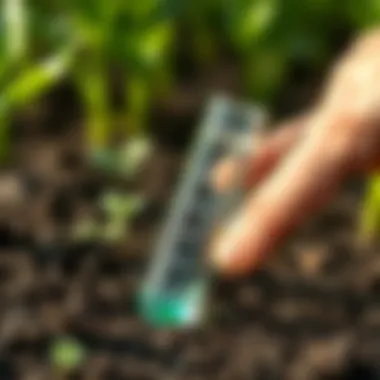Understanding Emerald Harvest pH Down in Plant Care


Intro
In the world of plant cultivation, where every nutrient and element plays a pivotal role in growth, managing the acidity or pH level of the growing medium cannot be overlooked. One specific tool that has gained respect among farmers and plant enthusiasts is Emerald Harvest pH Down. This product serves as a fundamental resource for adjusting soil and solution pH, ensuring that plants can absorb essential nutrients more effectively.
The importance of maintaining optimal pH levels is increasingly recognized in modern horticulture and agriculture. Lowering pH can improve nutrient solubility, enhancing plant biology and contributing to healthier growth. This article will hash out the significant aspects of Emerald Harvest pH Down, dissecting its formulation, practical applications, and benefits in varied cultivation settings.
Key Concepts and Terminology
When diving into the world of pH management in plant cultivation, it's essential to grasp some key concepts and terminology surrounding this subject. Understanding these basics provides insights that will support successful plant growth.
Basic Definitions
- pH Scale: The pH scale ranges from 0 to 14, indicating how acidic or alkaline a substance is. A pH of 7 is considered neutral, while anything below is acidic and above is alkaline.
- Nutrient Availability: This refers to the extent that essential nutrients can be taken up by plants, which is largely influenced by soil pH levels. Certain nutrients become more or less available depending on whether the soil is acidic or alkaline.
- Emerald Harvest pH Down: This is a commercially available product designed to reduce the pH of water and nutrient solutions, enabling better nutrient uptake by plants.
Historical Context
Historically, the management of pH levels in soil has roots that stretch back to early agricultural practices. Farmers have always understood the impact of soil composition on crop yield. While modern science has provided tools like Emerald Harvest pH Down, age-old knowledge remains relevant. The combination of empirical observations and scientific advancements has led to a treasure trove of techniques and methods.
The precision in pH management we see nowadays can be traced back to agronomical research and methodologies established in the mid-20th century. The advent of pH meters and other measurement tools revolutionized agriculture, allowing for more tailored approaches to nutrient management. So, while the fundamentals may not have changed, the tools certainly have evolved.
Recent Innovations and Trends
As the agricultural landscape constantly shifts, innovation remains at the forefront of successful farming techniques. Keeping abreast of recent trends related to pH management is crucial for those invested in cultivation practices.
Technological Advancements
Recent years have seen the advent of precision agriculture tools that assist farmers in understanding their pH needs at an unprecedented level. Automated systems can monitor pH levels in real-time, offering immediate feedback and solutions, like the integration of Emerald Harvest pH Down right into your irrigation system. This technology helps those nurturing plants maintain stability and growth potential.
Sustainable Practices
Moreover, sustainability is taking center stage. When utilizing Emerald Harvest pH Down, not only can farmers achieve optimum acidity levels, but they can do so without resorting to harsh chemicals that might harm both plants and the environment. This product aligns with sustainable practices, promoting healthy ecosystems while still delivering results.
Practical Applications and Techniques
Understanding the role of pH adjustment practices is essential for practical application within diverse cultivation settings. Here are some actionable insights:
Step-by-step Guide
To utilize Emerald Harvest pH Down effectively, follow these steps:
- Measure pH: Use a reliable pH meter to determine the current pH level of your soil or nutrient solution.
- Calculate: Based on your measurements, calculate how much pH Down you’ll need to reach your desired level.
- Mix: In a separate container, mix the pH Down with water according to the manufacturer’s instructions.
- Adjust: Slowly add the mixture to your soil or nutrient solution, monitoring the pH level as you go.
- Re-test: After allowing some time for absorption, measure the pH again to ensure it’s within the desired range.
Case Studies
Consider a home gardener using Emerald Harvest pH Down in a hydroponic system. They noticed the nutrient solution was too alkaline at a pH of 8.5. By applying the above steps, they successfully lowered it to 6.0, resulting in vibrant plant growth and improved yield. They not only enhanced plant health but also understood the crucial relationship between pH levels and nutrient uptake.
"Adjusting pH levels is not just a chemistry lesson; it's essential ag-driven art that turns quality soil into a thriving garden."
By infusing practical knowledge and utilizing products like Emerald Harvest pH Down, farmers can indeed craft the optimal environment for their plants to thrive.
Intro to pH Management in Agriculture
Understanding pH management in agriculture is crucial for any grower seeking to optimize plant health and crop yield. Acidity levels in the soil can act like a hidden engine, driving or stalling the growth of plants.
When we talk about pH, we’re essentially discussing the balance between acidity and alkalinity in soil. This balance can influence a plant's ability to absorb vital nutrients. So, why does this matter? The right pH level ensures that plants not only get the nutrients they need but also thrive in their environment. A mismanaged pH can lead to nutrient deficiencies, diminished growth, or even plant death.
Growers often find themselves at a crossroads, deciding how to manage their soil conditions effectively. In this ever-evolving field of agriculture, being able to manipulate pH levels with products like Emerald Harvest pH Down provides a significant advantage. Using such tools can lead to a more productive growing season and help farmers to achieve consistency in their produce.
Another key consideration when discussing pH management is the presence of a diverse array of crops. Different plants exhibit varying tolerances to pH levels. A crop that's flourishing in one field might be struggling in another simply due to this specific aspect.
Highlighting the relevance of pH management, particularly focusing on products designed to lower acidity, we can foster a more robust understanding of their applications in different soil types, climates, and even growing techniques like hydroponics. In this article, we will delve into both the technical aspects and practical applications of Emerald Harvest pH Down, matched with a deep dive into why getting the pH just right can make all the difference in the world.
Importance of pH Levels
pH levels can determine which nutrients are available for plants. For instance, certain essential nutrients, like nitrogen, phosphorus, and potassium, become readily available in slightly acidic to neutral conditions, which range from pH 6 to 7.5. Outside this range, you may find essential nutrients locked away, rendering them useless to plants.
Moreover, pH levels can also regulate microbial activity in the soil. Soil bacteria, which are crucial for breaking down organic matter and supporting nutrient cycling, prefer specific pH conditions. If the pH is too low or too high, these microorganisms may become inactive, jeopardizing the soil’s health and fertility.
"Managing pH is not just about chemistry; it's about chemistry that leads to real-world results in the field."
Incorporating tools like Emerald Harvest pH Down allows for better control over these levels, providing the necessary adjustments to ensure that plants grow strong and healthy. In short, paying attention to pH means taking charge of your crop's destiny.
How pH Affects Plant Growth
There’s a profound connection between pH levels and plant growth dynamics. Think about it: just like you wouldn’t enjoy food that’s too spicy or too bland, plants thrive within certain pH ranges too. When the pH is optimal, plants grow robustly, develop more vibrant colors, and yield higher quantities of fruit or flowers.


On the flip side, if the pH strays too far from the ideal, it can stunt growth considerably. For example, if the soil is too acidic, it may lead to aluminum toxicity; the roots struggle to absorb water and key nutrients, leading to poor health. In contrast, highly alkaline soils can result in deficiencies in essential micronutrients like iron, causing chlorosis or yellowing of leaves.
The relationship between pH, nutrient absorption, and plant health is intricate but essential. It’s a balancing act that requires constant monitoring and, at times, intervention. Using Emerald Harvest pH Down can simplify this process, proving to be a quick fix without over complicating things.
As farmers and growers, understanding the nuances of pH can set the stage for thriving plants, bountiful harvests, and ultimately, a profitable venture. In the following sections, we��’ll look closer at how Emerald Harvest pH Down plays a pivotal role in achieving those desired outcomes.
Emerald Harvest pH Down: An Overview
In the intricate world of agriculture, where every detail counts, understanding the importance of Emerald Harvest pH Down is key for optimizing plant growth. This product plays a crucial role in managing soil and water acidity, which in turn impacts nutrient uptake and overall plant health. By maintaining the right pH levels, farmers can significantly influence the success of their crops. This overview illustrates the significance of this tool, exploring how it operates and its benefits.
What is Emerald Harvest pH Down?
Emerald Harvest pH Down is a concentrated liquid acid designed specifically to lower pH levels in nutrient solutions and soils. It’s formulated from a blend of suitable acids that are effective in adjusting the acidity of water and soil media, crucial for plant cultivation. Often, plants thrive within a specific pH range, generally between 6.0 to 7.0 for most crops. With the pH balance tipped too far to the alkaline side, plants struggle to absorb essential nutrients, resulting in poor growth and yield. Here’s where pH Down comes into play.
This product is particularly useful for hydroponic systems, where nutrient solution pH needs frequent adjustments. It can also be applied in traditional soil cultivation methods, making it versatile for all types of growers. The ability to fine-tune acidity levels allows for enhanced control over the cultivation environment, leading to healthier plants.
Chemical Composition and Functionality
The chemical makeup of Emerald Harvest pH Down typically includes phosphoric acid or sulfuric acid, both of which effectively mitigate high pH levels.
- Phosphoric Acid: Apart from lowering pH, it also contributes nutrients. Phosphorus plays a role in plant energy transfer, encouraging root development and flowering.
- Sulfuric Acid: This helps by providing sulfate ions, crucial for various plant functions, including protein synthesis.
When applied, pH Down works by dissociating in water to release hydrogen ions. These ions interact with the alkaline components present, effectively lowering the overall pH. The precision of this product ensures that growers can tailor the acidity levels according to the specific needs of their plants, without the guesswork that's often involved with manual adjustments.
The back-and-forth nature of pH management can be likened to a seesaw; to achieve balance, one must carefully assess and apply the right measures.
By utilizing Emerald Harvest pH Down, cultivators are not only enhancing the nutrient availability in their systems but are also fostering an optimal environment for their plants to thrive. It streamlines a process that, if neglected, can lead to nutrient lockout, affecting the entire crop's health.
Understanding both the functionality and composition of this product empowers farmers and horticulturists to achieve better outcomes in their cultivation practices. With its ease of use, growers can effectively manage their plants’ needs, ensuring lush, green growth year-round.
Understanding Soil pH and Its Effects
Soil pH plays a pivotal role in agriculture, impacting everything from seed germination to crop yield. It serves as the foundation upon which plant roots can absorb essential nutrients. For gardeners and farmers aiming for success, an understanding of how pH fluctuates through various soil types and seasons becomes a game changer. Since Emerald Harvest pH Down is built for managing such acidity levels, grasping the nuances of soil pH is crucial for effective plant cultivation.
Soil Type and Its Influence on pH
Soil is not just dirt; it’s a living entity that comes in many compositions, each with its own unique pH balance. The type of soil—whether sandy, loamy, or clay—harbors varying properties that can significantly modify its acidity or alkalinity. For instance, sandy soils often metabolize nutrients more quickly but can easily shift in pH, making them susceptible to fluctuations with rainfall or irrigation. On the other hand, clay soils, dense and heavy, tend to hold onto nutrients for a longer period, often leading to consistently wetter conditions that can lower pH levels over time.
To put it plainly, knowing your soil type is your first step in mastering pH management. Factors such as organic matter content can also change the soil's pH. For example, adding compost enriches the soil with beneficial microorganisms, which can moderately lower pH as they break down organic material.
"Understanding your soil is fundamental: it’s not just about growing plants; it’s about nurturing life beneath the surface."
The Impact of pH on Nutrient Availability
It's often said that nutrient availability is like an orchestra; you need all the instruments to be in tune to achieve harmony within the soil. Soil pH directly influences how plants access nutrients. At a pH of around 6 to 7, most essential nutrients like nitrogen, phosphorus, and potassium are readily absorbed by plant roots. However, as you venture outside this range, particularly toward lower or higher pH levels, some nutrients can become locked away, essentially making them useless to plants.
For example, in acidic soils with a pH less than 6.0, vital nutrients like phosphorus decline dramatically in availability. This can lead to stunted growth, poor fruiting, and ultimately, low yield. Furthermore, certain elements, like iron, may become soluble at low pH levels, causing deficiencies that affect plant color and vigor.
Farmers looking to manipulate soil health must take pH into account before applying fertilizers or nutrients. If the pH is not suitable, the plants may not be able to take up what you’re giving them, essentially meaning wasted resources. In that sense, using emerald Harvest pH Down intentionally can alleviate some challenges by subtly adjusting the soil chemistry, allowing for a more harmonious interaction between soil and plant.
In summary, understanding both the type of soil you’re working with and the role that pH plays in nutrient availability can provide farmers and gardeners with essential insights. A finely tuned pH can lead your crops to flourish, while ignorance might lead to suboptimal growth and yield.
Application of Emerald Harvest pH Down
Understanding when and how to apply Emerald Harvest pH Down is vital for ensuring optimal growth conditions for your plants. Proper application not only aids in the management of soil acidity but also enhances nutrient absorption crucial for plant health. It’s more than just a chemical adjustment; it’s about nurturing an environment where plants can thrive.
When to Use pH Down
Determining the right moment to use pH Down hinges on a couple of factors:
- Initial Soil Testing: Before making any changes, conducting a soil pH test is essential. It gives a clear view of what’s happening beneath the surface. A reading below 6.0 usually indicates that acidity is on the rise.
- Growth Stages of Plants: Different stages in a plant's lifecycle can hold different pH needs. Young seedlings often require stable pH levels for rooting, while nutrient-hungry flowering plants may need slightly more acidic conditions.
It's best to keep a close eye on the pH levels, particularly during periods of rapid growth.
Recommended Application Techniques
Utilizing Emerald Harvest pH Down effectively involves careful measurement and application. Here are steps you should follow to ensure you hit the mark:
- Dilution: Always mix pH Down with water before applying. A typical ratio is about 1 ml of pH Down for each liter of water. Stir well to ensure it’s mixed thoroughly.
- Drip Application: For those with an irrigation system, injecting pH Down through the drip line is effective. This method ensures uniform application over a larger area.
- Direct Soil Application: If you're applying it directly to the soil, do so during the watering session. This helps in immediate absorption.
- Monitor and Adjust: After application, let the soil sit for a bit and then retest the pH. Adjust if necessary, but avoid making drastic changes in a single application.
Dosage Guidelines for Different Plant Species
Every plant has unique needs when it comes to pH. Here are some general guidelines to follow based on specific types of plants:
- Leafy Greens (e.g., lettuce, spinach): Aim for a pH of around 6.0-6.5. Use about 20-30 ml of pH Down per 10 liters of water.
- Fruiting Plants (e.g., tomatoes, peppers): These usually prefer a slightly lower pH, around 5.5-6.0. Dosage can go up to 40 ml per 10 liters of water.
- Herbs (e.g., basil, cilantro): These thrive at pH levels closer to neutral, around 6.0-7.0, so use pH Down sparingly—roughly 10-20 ml per 10 liters.


Always keep in mind that these guidelines can vary based on soil quality, climate, and specific plant requirements.
Emerald Harvest pH Down is a powerful tool not only for managing acidity levels but also for enhancing the long-term success of your cultivation efforts. Proper application is as essential as having the right product on hand.
Benefits of Using Emerald Harvest pH Down
The use of Emerald Harvest pH Down offers numerous advantages for anyone involved in plant cultivation. Getting the pH levels right is no small feat, yet it can make all the difference between a flourishing garden and a struggling one. This section will delve into the specific elements and benefits of using Emerald Harvest pH Down, focusing on how it can boost several aspects of plant growth, health, and productivity.
Enhancing Nutrient Uptake
When it comes to plant health, the availability of essential nutrients is key. Imagine trying to drink from a narrow straw; that's what plants face when pH levels are out of balance. Too alkaline or too acidic soil can lock up vital nutrients, making it hard for plants to access what they need.
Emerald Harvest pH Down is a formulation specifically designed to help create an optimal acidic environment that enhances nutrient uptake. This means that when you adjust the pH properly with this product, you're essentially opening the floodgates for nutrients like nitrogen, phosphorus, and potassium. Every gardener knows that happy plants are those that can easily absorb nutrients.
- Benefits Include:
- Increased availability of macro and micronutrients
- Improved root development
- Better overall plant vigor
By using Emerald Harvest pH Down regularly, you'll find your plants not only look greener but also seem to thrive more vigorously. The result? More robust growth and possibly a larger harvest come harvest time.
Improving Plant Health and Yield
Healthy plants translate into higher yields, a fact that can't be overstated. Maintaining the correct pH using Emerald Harvest pH Down directly impacts plant health. When plants absorb nutrients efficiently, they also strengthen their defenses against pests and diseases. This leads to a more resilient garden or farm.
Consider this: just like humans need a balanced diet for good health, plants need the right pH balance to take full advantage of the nutrients provided. With the appropriate adjustments made, plants tend to show:
- Stronger growth patterns
- Increased resistance to diseases
- Enhanced flowering and fruiting capabilities
- Better overall yield
In the long run, using Emerald Harvest pH Down could mean the difference between a good harvest and a bumper crop. Not just for your plants, but also for your peace of mind knowing you're doing the right thing for your garden.
“If the roots are healthy, the plant thrives – it all starts with the soil.”
Integrating pH management tools like Emerald Harvest pH Down into your routine can elevate your gardening game. Remember, a little bit of proactive pH management can go a long way.
Potential Risks and Considerations
In the realm of plant cultivation, particularly when utilizing products like Emerald Harvest pH Down, it's essential to address the potential risks and considerations that accompany adjustments to soil acidity. While maintaining optimal pH levels is vital for nutrient availability and plant health, the act of altering these levels must be approached with caution. Mismanagement can lead to unintended consequences. Therefore, understanding the specific risks and their implications for both the environment and plant wellbeing is crucial for anyone engaged in agriculture, whether in a commercial setting or as a hobbyist.
Risk of Over-Acidification
One of the primary risks associated with the use of pH down products is the potential for over-acidification. Soil that becomes too acidic can create a hostile environment for plants. Over time, excessive acidity can adversely affect microbial activity in the soil, which plays a crucial role in nutrient cycling and overall soil health. Here are some key points to consider regarding this risk:
- Nutrient Lockout: When soil pH drops below optimal levels, certain essential nutrients such as calcium and magnesium become less available to plants. This phenomenon, known as nutrient lockout, can lead to deficiencies that stunt growth or cause other health issues.
- Plant Stress: Many plants prefer a certain pH range. A drastic shift towards acidity can stress plants, leading to symptoms like yellowing leaves or stunted growth. This stress not only affects plant productivity but can also make them more susceptible to pests and disease.
- Long-Term Effects on Soil Health: Continuous applications of pH down without proper monitoring can degrade soil structure and health over time. This degradation may necessitate costly remedial actions in the future, making it a challenge for sustainable farming practices.
"It’s easier to monitor pH levels than it is to recover from over-acidified soil." This quote underlines the importance of regular soil testing and careful management.
To mitigate these risks, regular soil testing becomes imperative. Farmers and gardeners should ensure they're not only aware of the initial pH changes but also how those changes are impacting nutrient availability and plant health over time.
Environmental Impact and Sustainability
As agricultural practices increasingly focus on sustainability, understanding the environmental implications of using synthetic pH adjusters like Emerald Harvest pH Down becomes crucial. While these products can enhance plant growth and health, they can also pose risks to the surrounding ecosystem if not used thoughtfully. Below are critical considerations regarding environmental impact and sustainability:
- Runoff Risks: When excess pH down products are applied, there's a risk that runoff may transport acidic substances into nearby water sources. This runoff can disrupt aquatic ecosystems, affecting fish populations and plant life in those areas, which is counterproductive to sustainable farming efforts.
- Soil Biodiversity: A healthy, balanced soil pH supports a diverse array of organisms that contribute to soil health. Continuous use of acidifying agents can diminish this biodiversity, resulting in a less resilient and more fragile ecosystem.
- Alternative Practices: Farmers and cultivators might explore alternative methods to manage pH levels organically, such as using compost or natural amendments like pine needles or sulfur. This encourages sustainable practices and minimizes the reliance on chemical products.
Overall, while Emerald Harvest pH Down presents an effective solution to manage soil acidity, it is vital to evaluate the pros and cons carefully. Emphasizing responsible usage and considering long-term effects will help ensure that farming practices maintain ecological balance and promote sustainability.
Alternative Approaches to pH Management
Finding the right balance of soil pH is crucial in farming. As we've seen with Emerald Harvest pH Down, managing acidity levels leads to better nutrient absorption and ultimately healthier plants. However, it's wise to explore alternative methods beyond synthetic solutions. This section will delve into organic alternatives and natural amendments, focusing on their benefits, considerations, and practical applications.
Organic Alternatives to pH Down
Organic alternatives offer a more holistic approach to pH management. Many farmers are turning to these methods, recognizing the value of sustainable practices. One popular organic option is wood ash. When added to soil, wood ash can raise pH, making it less acidic. It's a great option for those looking to balance out low pH levels naturally.
Another effective choice for lowering pH is sulfur. Applied to the soil, it reacts with soil moisture to form sulfuric acid, which helps to reduce pH levels over time. It’s particularly useful because it does not impact the overall soil structure like some synthetic products can.
Other organic materials such as compost and peat moss can also influence soil pH. Compost can introduce beneficial bacteria and fungi to your soil, which in turn can help in buffering pH changes. Additionally, the properties of peat moss can make it a good choice for acidifying soil, as its natural composition leans towards lower pH levels.
Using these alternatives can lead to a more resilient ecosystem while providing benefits like increased microbial activity. However, they may not show immediate results. Farmers should keep that in mind when transitioning to these more organic tactics.
Balancing pH with Natural Amendments
Natural amendments can play a vital role in balancing soil pH. These materials, be they rich in nutrients or just plain shape, assist in achieving optimal pH conditions without the harshness of chemical solutions. Gypsum is one compelling amendment. It helps in improving soil structure and can reduce soil acidity while providing calcium that plants need to grow.
Lime is another commonly used natural amendment and works opposite to sulfur. Lime raises pH levels and adds calcium and magnesium to the soil. It's quite favored in regions where soils are naturally acidic, making it a nifty way to naturally mitigate pH issues.


Utilizing compost, as mentioned previously, again fits into this category. By applying a thick layer of compost on the soil surface, it helps improve pH levels while enriching the soil with essential nutrients and enhances moisture retention.
It is important to perform soil tests regularly when using natural amendments, as the slow-acting nature means interactions can take time to show effects.
"Utilizing organic and natural methods is not just beneficial for plants, but also for the ground we cultivate. It’s a win-win, helping to create a richer, more fertile environment."
In the long run, when farmers incorporate these alternative methods into their practices, they not only manage pH but also support a thriving ecosystem. Balancing pH with natural amendments and organic alternatives leads to sustainable agriculture that can endure the test of time.
Case Studies of Effective pH Management
Managing pH levels is not just a theoretical discussion; it is a practice that manifests concrete results in fields and greenhouses around the globe. Exploring real-life case studies reveals how Emerald Harvest pH Down can make a significant difference in both hydroponic and soil-based settings. These examples underscore the importance of targeted pH management and how it can empower growers to achieve optimal plant health.
Successful Use in Hydroponics
Hydroponics is often seen as the cutting-edge frontier of agriculture. In a recent case in a California-based hydroponic farm, the use of Emerald Harvest pH Down was implemented to fine-tune the nutrient solution's acidity. This farm specializes in growing leafy greens, which frequently suffer from nutrient lockout if the pH is not in the desired range.
Through close monitoring, the team found that maintaining a pH between 5.5 and 6.5 was critical for maximizing the absorption of essential nutrients like nitrogen and iron. They noticed a stark difference when the acidic levels were manipulated using pH Down. Plants exhibited richer green colors and increased growth rates, all while reducing fertilizer inputs by about 15%.
“Hydroponic systems thrive on precision. Emerald Harvest pH Down helped us achieve the levels we needed to boost yield and reduce waste,” said farm manager, Chloe Morales.
To ensure continual success, the farm implemented regular testing and adjusting of pH levels based on the plant growth stages. Utilizing Emerald Harvest pH Down has led to produce that’s not only of higher quality but also more resilient to diseases, such as downy mildew, which can be more prevalent in poorly managed pH environments.
pH Management in Soil-Based Agriculture
Soil-based agriculture remains a cornerstone of farming despite technological advancements. In a case study from the Midwest, a wheat farmer faced declining yields due to poor soil pH levels. Historically, soil testing showed fluctuations between 6.0 and 8.0, leading to inconsistent growth and nutrient deficiencies.
By integrating Emerald Harvest pH Down into their agronomic practices, the farmer applied the solution during soil amendments. They found that bringing the soil pH more towards the neutral side—not just by adding the pH down product, but also by understanding its influence on limestone and compost applications—enhanced the soil’s fertility significantly.
The results over time were remarkable. Fields treated with pH Down yielded 20% more than adjacent fields that were not adjusted, and soil tests revealed improved micronutrient levels across the board. The farmer noted that common problems like stunted growth and delayed flowering became less frequent, leading to a bumper crop.
In both hydroponic and soil farms, it is clear that effective pH management, aided by Emerald Harvest pH Down, doesn’t merely fine-tune the growing conditions but builds a more sustainable farming future. The lessons learned from these case studies highlight the profound impact soil and nutrient management have on agriculture today.
Relevant References:
Future Trends in pH Management
As agriculture continues to evolve, the spotlight on pH management is growing ever brighter. The use of Emerald Harvest pH Down is just the tip of the iceberg in understanding how crucial optimal acidity levels are for plant health. The future of pH management revolves around incorporating advanced technology and precise data, facilitating a shift towards more sustainable agricultural practices. It’s not merely about treating the symptoms of improper pH levels but rather about creating a smart approach to achieve consistent results.
Technological Innovations
Innovation in technology plays a pivotal role in enhancing pH management strategies. Tools and devices that once seemed unreachable are now becoming commonplace in many agricultural settings. One prime example is the advent of automated soil pH monitoring systems.
These gadgets allow farmers to check acidity levels in real-time, providing immediate feedback and reducing the reliance on manual testing methods. When linked to irrigation systems, they can even automatically adjust the pH levels by introducing products like Emerald Harvest pH Down as needed. This precision not only conserves resources but also safeguards plant health.
Moreover, advancements in mobile applications are worth mentioning. Taking soil samples is no longer a tedious venture. With apps that can analyze collected data right on the field, farmers are empowered to make informed decisions swiftly. The amalgamation of these technologies aims to minimize human error and optimize the growing process. It’s safe to say that technology isn't just supporting agriculture; it's revolutionizing the way we approach every aspect of it, including pH management.
The Role of Data in Precision Agriculture
Data has become the compass guiding modern farming. In the realm of pH management, its presence is indispensable. With the shift towards precision agriculture, farmers are now equipped to analyze vast amounts of data that can influence their crops significantly.
For instance, correlations between pH levels and plant nutrient uptake can be understood better through detailed analytics. The targeted information obtained from soil sensors, historical yield data, and weather patterns allows for a more nuanced view of the farming landscape.
- Diverse Data Sources
- Soil moisture levels
- Ambient temperatures
- Crop growth rates
The aggregation of this data presents a clearer picture of how to manipulate and maintain ideal pH levels. Using models that project outcomes based on various inputs, farmers can anticipate challenges before they arise—saving time, resources, and hard-earned capital.
In summary, the fusion of technology and data in pH management not only enhances productivity but also encourages environmentally responsible practices. Looking ahead, the focus will be on harnessing these trends to enrich the agricultural landscape while ensuring sustainability and efficiency.
"By integrating technology and data, farmers can achieve a level of precision in pH management that was previously thought impossible, paving the way for healthier crops and more abundant yields."
Staying ahead of these trends will ensure that farmers not only survive but thrive in an industry that's constantly changing.
Finale
The closing remarks of this article serve to underscore the significance of pH management in agriculture, specifically through the lens of using Emerald Harvest pH Down. Effective pH control is not just a minor detail; it is a cornerstone of successful plant cultivation. Maintaining balanced pH levels paves the way for optimal nutrient uptake and enhances overall plant health, a fact that every grower should keep at the forefront.
Summary of Key Points
In this article, we have explored several essential aspects regarding Emerald Harvest pH Down:
- Understanding pH Levels: pH levels are critical for soil health and plant nutrition.
- Application Techniques: Knowing when and how to apply pH Down is fundamental for achieving desired results.
- Impact on Nutrient Availability: A well-managed pH influences the bioavailability of essential nutrients, which directly affects plant growth and yield.
- Benefits and Risks: While there are undeniable benefits of using Emerald Harvest pH Down, including improved nutrient absorption and healthier plants, its use comes with the caution of over-acidification.
Final Thoughts on pH Management
Looking ahead, pH management is becoming increasingly intricate, propelled by advancements in technology and agriculture science. As precision agricultural practices evolve, farmers are better equipped to monitor and adjust soil pH dynamically. With tools like Emerald Harvest pH Down, growers have more command over their cultivation environments, leading to not just higher yields but also healthier ecosystems in the long run.
Understanding and refining pH levels in soil is a continuous journey. It demands attention, ongoing education, and an openness to adapt strategies. Whether you're a seasoned farmer or a gardening aficionado, the insights derived from effective pH management can be transformative. By embracing these principles, agriculture can move towards a future of sustainability, yielding not just crops but knowledge and resilience.















